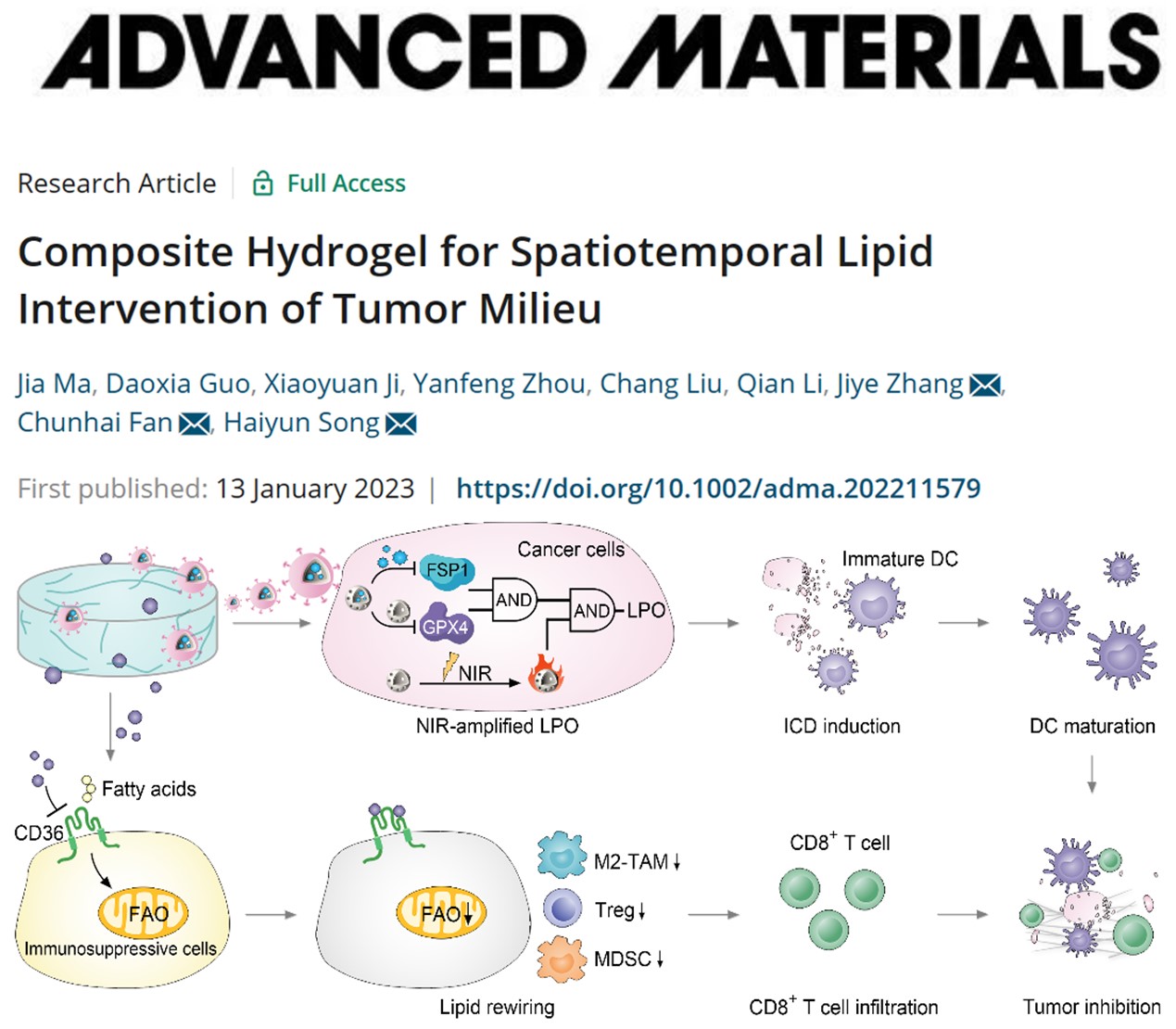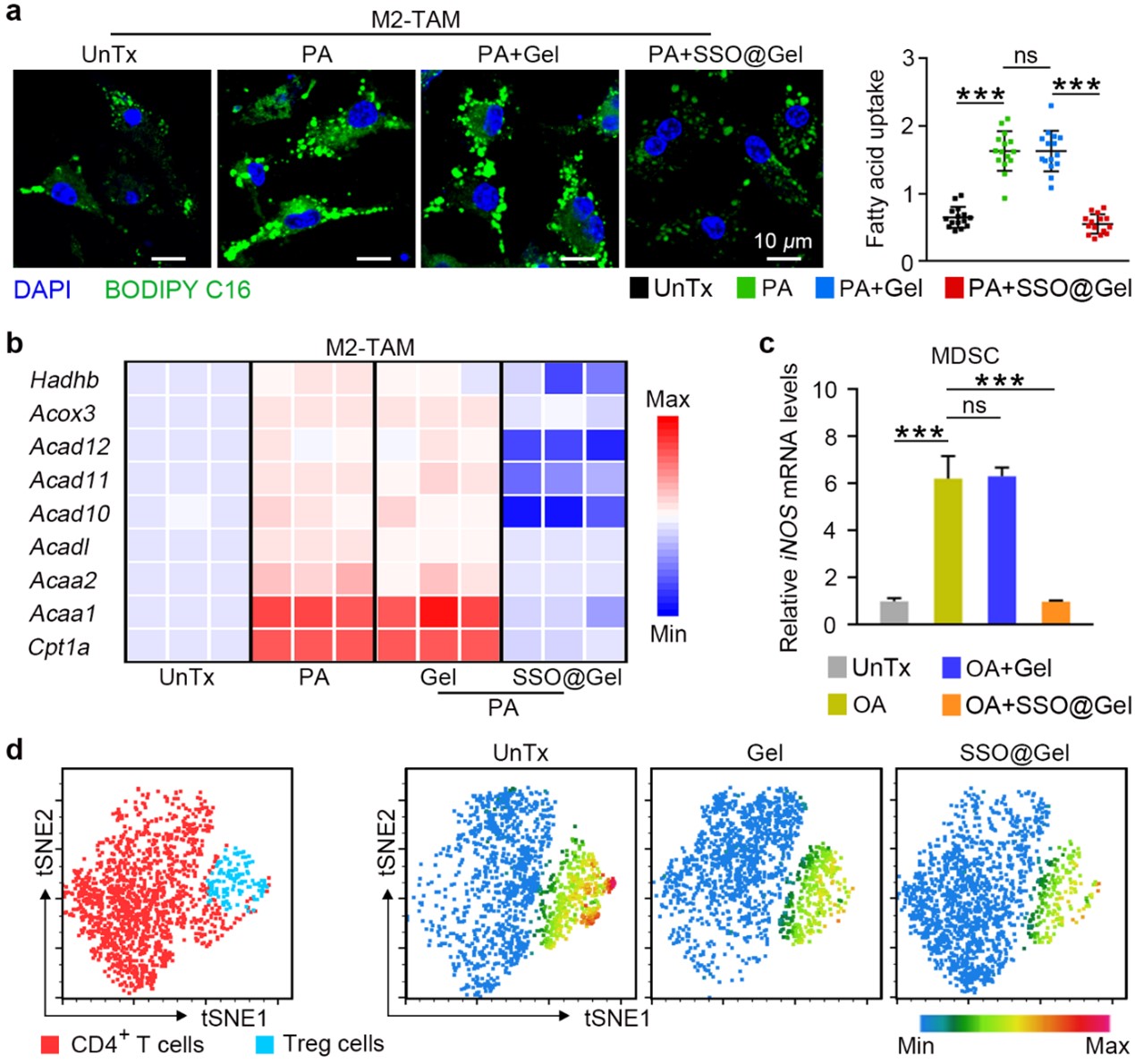Recently, Advanced Materials, a well-known academic journal, published an article entitled "Composite Hydrogel for Spatiotemporal Lipid Intervention of Tumor Milieu" by Professor Song Haiyun, School of Public Health, Academician Fan Chunhai, School of Chemistry and Chemical Engineering, Shanghai Jiao Tong University, and Professor Zhang Jiye, School of Pharmacy, Xi 'an Jiao Tong University. In this study, a type of composite hydrogel is fabricated to deliver nanoparticles (NPs) and small molecule inhibitors for spatiotemporal modulation of tumor cells and immunosuppressive cell populations. Combined with near-infrared photothermal therapy, an immunometabolic therapy via orchestrated lipid modulation in the tumor milieu is provided.
Immunogenic cell death (ICD) plays crucial roles in cancer immunotherapy, whereas its efficacy is severely compromised by redundant antioxidant defenses in cancer cells and aberrant lipid metabolism in immunosuppressive cell populations. This study finds that hollow mesoporous CuS NPs possess an intrinsic capacity of inhibiting the glutathione peroxidase 4 (GPX4). When loaded with an inhibitor of the ferroptosis suppressor protein 1 (FSP1), these NPs block two parallel redox systems and cooperate with near-infrared irradiation to reinforce ICD. Researchers further fabricate a hydrogel co-delivering cancer cell-targeting CuS NPs and immunosuppressive cell-targeting sulfo-N-succinimidyl oleate (SSO) for spatiotemporal lipid intervention. While the CuS NPs augment ICD via synergistic lipid peroxidation, SSO reinstates immune perception via lipid metabolic reprogramming, thereby coordinately triggering robust innate and adaptive immunity to restrain tumor growth, relapse and metastasis. This study provides a novel immunometabolic therapy via orchestrated lipid modulation in the tumor milieu.

Figure 1. Schematic illustration of anti-tumor strategy of composite hydrogel. Original from: Adv. Mater.
Ferroptosis is a form of ICD caused by lipid peroxidation. While it was generally believed that targeting the system xc-/glutathione (GSH)/GPX4 pathway, via cystine starvation, GSH depletion or GPX4 inhibition, dominated the accumulation of lipid hydroperoxides, recent studies reveal that many types of cancer cells can utilize the coenzyme Q10 (CoQ) oxidoreductase FSP1 and NAD(P)H to prevent ferroptosis when the canonical GPX4 pathway fails, which reduces the efficacy of tumor immunotherapy. The internalized CuS NPs show an intrinsic capacity of inhibiting GPX4 and act in parallel with iFSP1-mediated inactivation of FSP1 for enhanced lipid peroxidation, which further synergizes with the photothermal effect of CuS NPs to boost ICD.
In addition to cell-autonomous restriction of ICD induction, the unique metabolic characteristics of cancer cells create an immunosuppressive tumor microenvironment (TME) to blunt the perception of ICD by immune systems. Lipid metabolites in the TME accumulate aberrantly in tumor-associated immunosuppressive cell populations, such as the M2 type tumor-associated macrophages (M2-TAMs), myeloid-derived suppressor cells (MDSCs), and regulatory T (Treg) cells, promoting their differentiation and pro-tumorigenic functions. These cells are characterized by high expression of the CD36 receptor that mediates lipid uptake as a primary source of energy. Therefore, the blockage of lipid uptake can lead to the inhibition of the immunosuppressive cells and favors immune surveillance in the TME. In this study, the released SSO targets the CD36 receptor on the surface of MDSCs, M2-TAMs, and Treg cells for lipid uptake blockade and lipid metabolism reprogramming, which relieves their immunosuppressive phenotypes and subsequently promotes cytotoxic T cell infiltration.

Figure 2. Hydrogel-mediated lipid rewiring of immunosuppressive cells. Original from: Adv. Mater.
Having demonstrated the advantages of iF-CuS NPs and SSO@Gel in ICD induction and immune perception, respectively, the researchers further combine the two therapeutic modalities in one composite hydrogel for targeted regulation of both tumor cells and immunosuppressive cell populations in an orthotopic TNBC mouse model, which synergistically elicit innate and adaptive immunity to suppress tumor growth. In addition, the composite hydrogel exhibit a high efficacy against post-surgical relapse and metastasis in the TNBC model.
Haiyun Song, Professor, School of Public Health, Shanghai Jiao Tong University, Chunhai Fan, Academician, School of Chemistry and Chemical Engineering, Shanghai Jiao Tong University, and Jiye Zhang, Professor, School of Pharmacy, Xi 'an Jiao Tong University are co-corresponding authors of the paper. Ma Jia, a PhD candidate at Xi 'an Jiao Tong University, Guo Daoxia, a PhD candidate at Shanghai Jiao Tong University, and Ji Xiaoyuan, an associate researcher, are joint first authors of the paper.
Original link: https://onlinelibrary.wiley.com/doi/10.1002/adma.202211579




